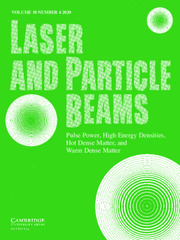No CrossRef data available.
Article contents
Slab model for Rayleigh–Taylor instability
Published online by Cambridge University Press: 09 March 2009
Abstract
A modelization of the Rayleigh–Taylor instability, in the context of inertial confinement fusion, is made by means of a planar slab model whose main features are a sharp ablation front separating the slab and the expanding corona, absorption of constant intensity laser light at a critical surface, profiles for background flow variables consistent with hydrodynamic equations, and heat conduction present in the expanding corona. A sharp ablation front assumption (density at the critical surface is much less than the slab density, ρc/ρs ≪ 1) supposes that the ablated mass is small, so the model is valid for thick targets. Two main regimes are modelized, subsonic and sonic absorption. The growth rate of the instability is obtained, and its variation with kD and kxc is studied (k = perturbation wavenumber; D = slab thickness; xc = ablation to critical surfaces distance). The model showsstabilization over the classical Rayleigh–Taylor growth rate (γ = √kg). The stabilization mechanism is based on heat conduction near the ablation front.
Information
- Type
- Regular Papers
- Information
- Copyright
- Copyright © Cambridge University Press 1996

